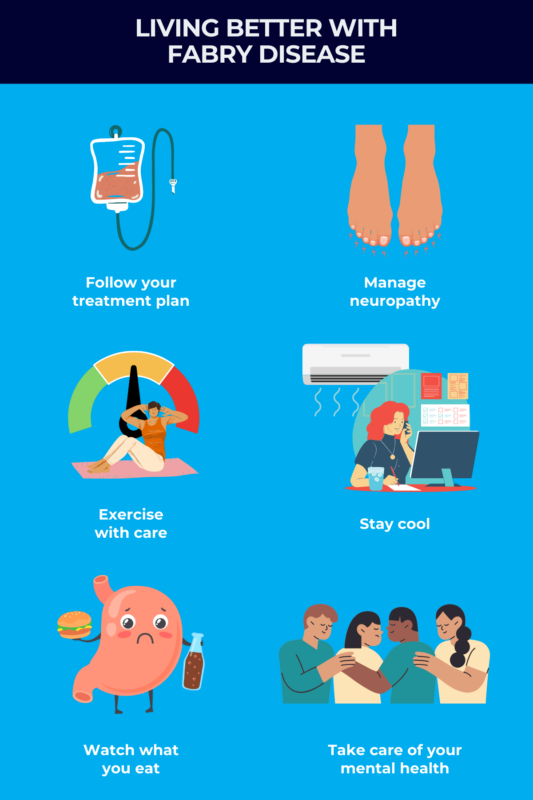Living with Fabry disease
Last updated Jul. 24, 2024, by Susie Strachan

Living with Fabry disease can be challenging. But having a better understanding of the condition and the ways to manage it can make a difference in your health, both physically and emotionally.
Fabry disease is a rare genetic disorder. The causes of Fabry are mutations in the GLA gene, which lead to certain fatty molecules accumulating to toxic levels inside cells.
Fabry disease treatment can manage symptoms, such as chronic pain, which is one of the most common Fabry disease symptoms. It can also slow or prevent progression of the disease.
Coping strategies and lifestyle changes, such as physical therapy, exercise, practicing mindfulness, and getting emotional support, can help with living a full life with Fabry.
How Fabry disease affects daily living
Fabry disease can affect your entire body, leading to pain in arms and legs, a red-spotted rash, and progressive loss of hearing and kidney function. It’s also associated with an increased risk of heart problems and stroke.
Fabry disease is often diagnosed in childhood. And Fabry disease symptoms worsen over time, making daily life — at home, school, and work — more challenging.
Anthony VanVickle was diagnosed at age 16, after noticing unusual symptoms. He lives near Dallas with his family, including his twin brother, Michael, who also has Fabry disease.
“I was a camp counselor, and one day, the kids were playing around, and I got hit in the stomach. It popped one of these things called an angiokeratoma, which happens sometimes,” he says. “And there were other symptoms that just didn’t make sense.”
Angiokeratomas are clusters of small, reddish-to-black spots on the skin. They mainly appear in the area between the belly button and the knees and become larger and more numerous over time.
VanVickle, who is now 21 years old and a college student, says his symptoms have progressed. He has pain due to nerve damage in the bigger joints, including his hands, feet, and knees, especially when it gets cold. He also can’t sweat, so his body isn’t able to cool itself, which limits the time he can spend outside in hot weather or playing sports.
“I’ve learned to stay indoors. When I want to do something active, like powerlifting, I’ve learned to shower both before and after,” he says. “I played football and worked in landscaping. I do have to be careful, otherwise I can get heat stroke quickly.”
Treatment options
While there isn’t presently a cure for Fabry disease, there are a number of treatments that can improve symptoms. These include Fabry disease medications that address the root causes of Fabry as well as treatments for specific disease symptoms and complications.
And there is hope for the future as a better understanding of the disease, earlier diagnosis, and advancements in treatment are making a difference in Fabry disease life expectancy and quality of life.
The main treatment options approved for slowing disease progression and easing disease symptoms in Fabry are enzyme replacement therapy (ERT) and chaperone therapy.
But as the disease causes organ damage, you may need other treatment approaches that are not approved specifically for Fabry but help to manage issues such as kidney disease, heart disease, and digestive problems. These may include:
- beta-blockers, ACE inhibitors, and other heart medications to manage heart symptoms and protect heart function
- ACE inhibitors to protect kidney function and manage high blood pressure
- dialysis to filter waste products from the blood or, in some cases, a kidney transplant
- medications to treat gastrointestinal symptoms such as nausea, diarrhea, and abdominal pain.
There are a number of experimental approaches in development for treating or even potentially curing Fabry disease.
VanVickle is in a clinical trial that required him to stop his previous treatment — which he received as an infusion every two weeks — for six months to clear the medication from his body.
“I was able to study abroad, in Florence, Italy, while I waited for the trial to start,” he says. “So I managed to fit in a life goal.”

Pain management
Managing pain from Fabry disease typically involves a multifaceted approach, including ERT or chaperone therapy to reduce buildup of fatty molecules and pain-relieving medications.
Pain may be from:
- peripheral neuropathy, which is nerve damage that causes tingling, burning sensations, or numbness, especially in the hands and feet
- gastrointestinal issues causing abdominal pain and cramping, often made worse by eating
- inflammation and damage caused by fat deposits, which can also contribute to pain throughout the body
- overactive sensory nerve cells, which may cause you to experience pain from touch or other stimuli that do not normally elicit pain.
Your doctor may recommend painkillers, but other ways to help reduce pain include:
- taking frequent breaks to prevent fatigue
- napping to restore energy levels
- staying in a cool environment to avoid overheating
- avoiding strenuous exercise that can trigger pain.
Exercise and physical therapy
Fabry disease can impact your ability to exercise. Even mild activity may be tiring and trigger pain.
While you want to avoid overexerting yourself, sometimes a moderate level of exercise along with physical therapy can help increase energy levels.
Regular, low-impact exercise, such as walking, swimming, or cycling, can help maintain overall physical health, improve circulation, reduce muscle stiffness, and help you feel better mentally and physically.
Always talk with your healthcare provider before starting a Fabry disease exercise program. And if you do exercise, go slowly and pay attention to your body to avoid triggering pain.
Fabry disease physical therapy focuses on improving mobility and strength and treating areas of discomfort.
A physical therapist may suggest exercises that help build muscle strength and endurance or increase flexibility to help reduce muscle tension and soreness.
They can also tell you other ways to relieve pain, manage energy levels, and avoid fatigue.
Diet
Gastrointestinal (GI) problems are often one of the earliest signs of Fabry disease.
While there isn’t a specific Fabry disease diet, some dietary habits may help prevent or alleviate symptoms like cramps, abdominal pain, diarrhea, and constipation.
Some changes to try include:
- having smaller, more frequent meals
- eating a well-balanced diet that includes a variety of fruits, vegetables, lean proteins, and whole grains
- choosing lean protein sources such as chicken, fish, tofu, and legumes that are easier to digest
- drinking plenty of water to stay hydrated.
In addition to limiting alcohol, you may want to avoid eating:
- fried or greasy foods
- spicy foods
- caffeine
- dairy products.
Talk with your doctor about supplements or medications that can help with digestion. A registered dietitian can work with you to figure out a good nutrition plan for relieving your GI symptoms.
Mental health
Managing Fabry disease and mental health can reduce stress and anxiety.
Seeing a mental health counselor and joining support groups may help you and your family in coping with Fabry disease. Mental health support can increase resilience and your ability to handle the daily challenges of living with a chronic illness.
VanVickle says he has good and bad days, but his life philosophy gets him through the worst moments.
“I’ve had to learn that these are the cards you play with and it’s going to be rough,” he says. “There are going to be days you don’t want to get out of bed.”
Instead of dwelling on what could make him sad, VanVickle focuses on finding joy in life, happiness in the moment, and moving forward with hope.
Along with mental resets and eating a healthy diet, VanVickle has other tips for improving mental health when living with Fabry:
- Make sleep a priority.
- Keep your bedroom cool.
- Stick with your exercise program.
- Take frequent showers, both before and after events or exercise.
- Give yourself as many little wins as possible.
- Acknowledge your physical pain — but don’t make comparing your pain with that of others a competition.
- Connect with real people, not just online.
- Find a mental health counselor you trust.
Other coping strategies can include:
- practicing mindfulness or meditation, deep breathing exercises, and progressive muscle relaxation
- letting friends and family know when you need help
- learning cognitive behavioral therapy techniques to challenge negative thought patterns and develop more positive ways of thinking
- doing enjoyable activities such as hobbies, reading, listening to music, or spending time in nature.
Useful resources and support
A good support network and access to useful resources is an important part of Fabry management.
Some key members of your support network can include family and friends, your healthcare providers, patient advocacy organizations, and online communities.
Fabry Disease News is a reliable source of information about the disease, the latest news about treatments and clinical trials, and columns sharing personal experiences.
In-person and online Fabry disease support groups can connect you with others living with the disease for emotional support, advice, and learning more about the disease itself.
Other useful resources for support and education about Fabry include:
- National Fabry Disease Foundation
- Fabry Support and Information Group
- Fabry Connect
- Canadian Fabry Association
- Fabry International Network.
Fabry Disease News is strictly a news and information website about the disease. It does not provide medical advice, diagnosis, or treatment. This content is not intended to be a substitute for professional medical advice, diagnosis, or treatment. Always seek the advice of your physician or other qualified health provider with any questions you may have regarding a medical condition. Never disregard professional medical advice or delay in seeking it because of something you have read on this website.
Recent Posts
- Fabry disease may raise risk of renal cell carcinoma: Study
- Myeloid bodies may aid in Fabry diagnosis, treatment monitoring
- Life must go on, even when Fabry disease symptoms flare up
- Fabry disease treatment ST-920 improves kidney function: Data
- Unexpected health events are part of my life with Fabry disease
- Blood biomarkers may reflect disease activity, kidney function
- Real-world study shows burden of heart, other complications in Fabry
- Study identifies eye changes in Fabry that could affect vision
- 5 tips for helping teens with Fabry disease to thrive
- Death of bone tissue a rare, painful Fabry complication: Case report
Related articles






